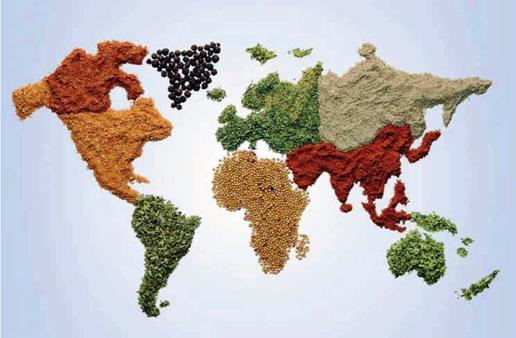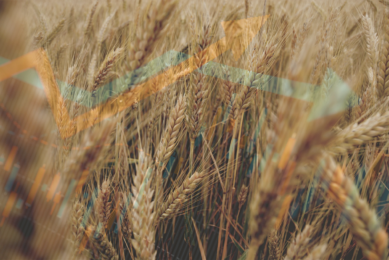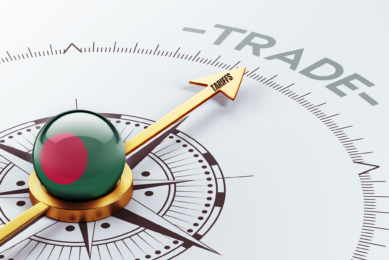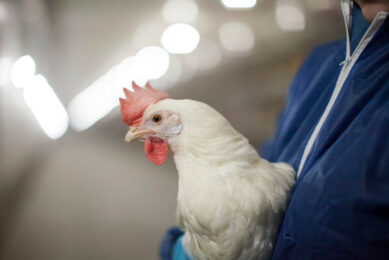Global Survey: Feed production reaches record of 873 million tonnes

The world’s feed production has reached an estimated 873 million tonnes, according to a global survey commissioned by Alltech. Conducted through Alltech’s regional managers, the survey assessed the tonnage of 132 countries and all species. A market research company has put a value on global feed production. And it was a busy year for mergers and takeovers.
Feed production has become an increasingly global phenomenon. Yet, traditionally, global output has been difficult to quantify because many countries lack a national feed association. Alltech commissioned a global survey for 2012, leveraging its global presence to obtain a finer estimate of the world’s feed tonnage. The survey, carried out through Alltech’s regional managers, assessed the tonnage of 132 countries and all species.
“This new global estimate is quite significant, especially when compared to the 2010 Watt report, which indicated 717.6 million tonnes,” said Aidan Connolly, vice president of corporate accounts at Alltech. “Feed production is an increasingly global phenomenon and this survey is the broadest in its reach and, therefore, also complete in terms of its review of the state of play in the world feed industry.”
Asia has secured a position as the number one feed producing region with a tonnage of 305 million, and China is the leading country with a total tonnage of 175.4 million. Europe follows Asia with 200 million. North America, Latin America and the Middle East/Africa complete the listing with 185 million, 125 million and 47 million tonnes respectively.When analysed by species, the 2012 Alltech Global Feed Survey affirmed poultry’s dominant share of the tonnage market with 379 million or 44% of the global market. This may reflect cost as well as the health and religious preferences for the white meat. Poultry was defined as broilers, layers, turkey and other fowl.
Ruminant feed is calculated at more than 220 million tonnes but this does not include a similar quantity of dry matter fed as silage or forage on farm. Pig, equine (9.3 mt) and pet feed (25.6 mt) numbers did not indicate a significant change over previous studies. However, aquaculture’s measurable advances establish it as the fastest growing feed sector with nearly 30 million tonnes.
China leads the pack
Among the 132 countries surveyed, China was the chief producer of feed at 175.4 million tonnes. As expected, the US and Brazil followed with 164.9 million tonnes and 59.6 million tonnes respectively.
Among the 132 countries surveyed, China was the chief producer of feed at 175.4 million tonnes. As expected, the US and Brazil followed with 164.9 million tonnes and 59.6 million tonnes respectively.
According to the International Feed Industry Federation, compound feed production is dominated by the US, European Union, China and Brazil. As indicated in the 2012 Alltech Global Feed Survey however, several new countries – such as Japan (24.9 mt), India (23.4 mt) and Canada (20 mt) – are emerging among the top ten as strong players in the global feed scene.
The survey also reflected the emergence of the Asian industry with a number of countries, including Thailand (12.4mt), the Philippines (11.6mt) and Vietnam (8.9mt), ranking among the top twenty. The countries’ significant numbers contributed heavily to Asia’s ranking as the highest producing region.
Far more feed than assumed
Of greatest significance, the 2012 Alltech Global Feed Survey indicates that the world’s feed production has reached an estimated 873 million tonnes. A previous estimation in the 2010 Watt Feed Survey report said that the global output of compound feeds grew by 1% in 2009 to 707.6 million tonnes and to 717.6 million tonnes (+1.4%) in 2010. A combined Fefac/Watt estimate put global feed production in 2010 at 722 million tonnes. These data are based on the same countries included in their previous reports. The primary difference between the reports may be the larger number of countries reviewed in the Alltech Survey. And even this survey might provide a low estimation. For example Indonesia is listed in Alltech’s list as manufacturing 8.6 million tonnes of feed. But the Indonesian Feed Mill Association recently said that feed use in Indonesia in 2011 reached 11.2 million tonnes, almost one million tonnes higher than predicted in 2010. In 2010, feed consumption was approximately 9.7 million tonnes. However, it is not clear if this feed is all manufactured in the country or partly imported.
Of greatest significance, the 2012 Alltech Global Feed Survey indicates that the world’s feed production has reached an estimated 873 million tonnes. A previous estimation in the 2010 Watt Feed Survey report said that the global output of compound feeds grew by 1% in 2009 to 707.6 million tonnes and to 717.6 million tonnes (+1.4%) in 2010. A combined Fefac/Watt estimate put global feed production in 2010 at 722 million tonnes. These data are based on the same countries included in their previous reports. The primary difference between the reports may be the larger number of countries reviewed in the Alltech Survey. And even this survey might provide a low estimation. For example Indonesia is listed in Alltech’s list as manufacturing 8.6 million tonnes of feed. But the Indonesian Feed Mill Association recently said that feed use in Indonesia in 2011 reached 11.2 million tonnes, almost one million tonnes higher than predicted in 2010. In 2010, feed consumption was approximately 9.7 million tonnes. However, it is not clear if this feed is all manufactured in the country or partly imported.
Market size in dollars
The Global Compound Feed Market is expected to attain a market size of US$ 308.5 billion by 2017 according to a report from Transparency Market Research (TMR). This bureau estimates the current feed market to be $ 257 billion and expects a compound annual growth rate (CAGR) of 3.72% over the period 2012 to 2017, which ultimately would lead to a $308 billion market in 2017. Swine feed would account for the largest share at 31% of the compound feed market in 2012 and will also be the fastest growing segment at a CAGR of 3.92% until 2017. TMR values the swine feed segment at $81.1 billion in 2017. Compound feed grew significantly worldwide over the past five years with a growth rate of 3.94%. Swine feed is expected to account for the largest share i.e. 31% of global compound feed spending at $81.1 billion in 2012. Moneywise, North America is consistently maintaining its leadership in the compound feed market with market revenue of $72.3 billion in 2010. Asia has the most promising growth potential for the compound feed industry as the consumption of animal derived products is increasing on account of their rise in disposable income.
The Global Compound Feed Market is expected to attain a market size of US$ 308.5 billion by 2017 according to a report from Transparency Market Research (TMR). This bureau estimates the current feed market to be $ 257 billion and expects a compound annual growth rate (CAGR) of 3.72% over the period 2012 to 2017, which ultimately would lead to a $308 billion market in 2017. Swine feed would account for the largest share at 31% of the compound feed market in 2012 and will also be the fastest growing segment at a CAGR of 3.92% until 2017. TMR values the swine feed segment at $81.1 billion in 2017. Compound feed grew significantly worldwide over the past five years with a growth rate of 3.94%. Swine feed is expected to account for the largest share i.e. 31% of global compound feed spending at $81.1 billion in 2012. Moneywise, North America is consistently maintaining its leadership in the compound feed market with market revenue of $72.3 billion in 2010. Asia has the most promising growth potential for the compound feed industry as the consumption of animal derived products is increasing on account of their rise in disposable income.
Global movements
Movements in the animal feed processing industry are rarely about autonomous growth. Also growth for most companies cannot be found within country borders. However extremely large companies tend to forget their smaller client, which leaves opportunities for smaller feed companies to enlarge their client base or as a Dutch risk entrepreneur once said: “There is a lot of space between the legs of an elephant.”
Movements in the animal feed processing industry are rarely about autonomous growth. Also growth for most companies cannot be found within country borders. However extremely large companies tend to forget their smaller client, which leaves opportunities for smaller feed companies to enlarge their client base or as a Dutch risk entrepreneur once said: “There is a lot of space between the legs of an elephant.”
There are a few areas that are of interest in animal feed production developments. Of course there is China, but also other countries in Asia, such as Thailand and Vietnam are starting to stir in the global feed picture. In China the New Hope Group (NHG) of billionaire Liu Yonghao is clearly looking for further expansion. Already being the biggest feed producer in China, NHG has teamed up with Japan’s biggest grain trader Marubeni to expand in Africa, the Middle East, Eastern Europe and South America.
NHG has been expanding its overseas business in the face of fierce competition in the animal feed business in China, the company said in its latest annual report. It plans to double its investment in overseas markets annually, according to the company’s website. The company now has 16 feed factories overseas, and it plans to add four more annually. Each overseas factory will have a production capacity of between 100,000 and 200,000 tonnes. NHG has already presence in Cambodia, the Philippines, Indonesia, Vietnam, Bangladesh and Egypt. Now it is looking to expand in other areas, such as Africa (Johannesburg, South Africa) and the Middle East. Marubeni has also taken a minority stake in the Liuhe-offshoot, Tianrun Feed. Liuhe Group in China is owned for 45% by NHG.
Entanglement
Feed companies in Asia are becoming more entangled. Apart from the NHG-Marubeni example another example is the Japan-based Sojitz Corporation which has entered the feed business in Cambodia by acquiring a 10% interest in Sichuan New Hope Agribusiness (Cambodia), a feed manufacturer in Cambodia owned by NHG. It is the first time that a Japanese company has entered the livestock compound feed production and sales business in Cambodia. Sojitz Group and Kyodo Shiryo Company (Japan’s leading animal feed producer) aired plans to inject $26 million into building an animal feed plant in Vietnam to obtain a 10% market share by 2020.
Feed companies in Asia are becoming more entangled. Apart from the NHG-Marubeni example another example is the Japan-based Sojitz Corporation which has entered the feed business in Cambodia by acquiring a 10% interest in Sichuan New Hope Agribusiness (Cambodia), a feed manufacturer in Cambodia owned by NHG. It is the first time that a Japanese company has entered the livestock compound feed production and sales business in Cambodia. Sojitz Group and Kyodo Shiryo Company (Japan’s leading animal feed producer) aired plans to inject $26 million into building an animal feed plant in Vietnam to obtain a 10% market share by 2020.
Another Chinese feed and food conglomerate is also on an expansion track. Cofco has started a new feed project in Hebei that will reach 200,000 tonnes of output in the first of three planned phases. Here also a Japanese connection is established with affiliates of Japan’s Mitsubishi Corporation.
Increased demand because of increased meat production makes feed companies grow, but market distortions can also force companies to consolidate. Take for example the outbreak of foot and mouth disease (FMD) in South Korea. There were 40 animal feed producers in early-2000, but that number has shrunk to 30, data of the Korean Animal Feed Association said.
Consolidation had slowed in recent years, but with the fourth and largest animal disease outbreak since the year 2000, merger and acquisition activity is picking up pace. Animal farming and agricultural companies such as Easy Bio System, Farmsco, CJ Feed and Sajo Bio Feed could be potential buyers. Easy Bio System, which bought a 70% stake in the stock farming company Sunghwa Food in 2010, was about to close another deal with an animal feed company, but so far has not succeeded. Additionally Farmsco has been approached by several undisclosed small-sized players if it would be interested in taking over their business. In Asia, by far the largest player is Charoen Pokphand Foods (CPF) which has its HQ in Bangkok, Thailand. It recently acquired its Hong Kong operation from the Cheravanont family as part of its strategy to become one of the world’s top three animal-feed firms. CP Pokphand Co (the Chinese arm of CPF) took a 70% stake in Modern State in Vietnam. Modern State has a 20% share of Vietnam’s commercial feed market and 30% of its broiler-farming market.
Eastern European giants
The Ukrainian agricultural holding UkrLandFarming completed the purchase of Avangard, the Ukraine’s largest producer of shell eggs and egg products. Owned by Oleg Bakhmatyuk, UkrLandFarming became the owner of the largest land bank in Ukraine with almost 500,000 ha, 65,000 head of cattle, and 24 mln chicken. The company owns, among others, six feed mills, six sugar factories, three elevators with storage capacity of 645,000 tonnes, four silos and 110 flour-storages. The combined companies in the Ukraine cover app. 14.3% of the beef market, 3% of grain production, 8.6% of sugar production, and 26% of egg production.
The Ukrainian agricultural holding UkrLandFarming completed the purchase of Avangard, the Ukraine’s largest producer of shell eggs and egg products. Owned by Oleg Bakhmatyuk, UkrLandFarming became the owner of the largest land bank in Ukraine with almost 500,000 ha, 65,000 head of cattle, and 24 mln chicken. The company owns, among others, six feed mills, six sugar factories, three elevators with storage capacity of 645,000 tonnes, four silos and 110 flour-storages. The combined companies in the Ukraine cover app. 14.3% of the beef market, 3% of grain production, 8.6% of sugar production, and 26% of egg production.
In Russia the Sodrugestvo Group is gaining ground. Founded in 1994 by a group of private investors Sodrugestvo recently acquired Bal-Tran, adding 1,875 grain hoppers and 102 boxcars to the Group’s logistics operations. By acquiring Brazilian grain handling company Lider Armazens Gerais, Sodrugestvo’s static storage capacity grew from the existing 600,000 tonnes to almost 900,000 tonnes in the states of Sao Paulo, Minas Gerais and Goias. In 2010, Sodrugestvo crushed more than 1.1 million tonnes of soybeans and rapeseed, making it a leading player in Northern, Central and Eastern Europe. Headquartered in Luxembourg, the company has 32 facilities located in nine countries including Russia, Denmark, Brazil, the United States and several Eastern European nations.
Cargill’s hunger
Extremely active on the takeover path in 2011 was US based and family owned Cargill, residing in the top three of global feed production. The family spent €1.5 billion to acquire Provimi from investment company Permira. In an acquisition spree it is estimated that Cargill spent €4.5 billion in 2011 in feed and food takeovers. To name a few, grain trader AWB in Australia, feed miller Raggio di Sole in Italy and a shrimp feed mill from Higashimaru Vietnam Co. Most remarkable was of course the acquisition of animal feed company Provimi, which was snatched before rivals New Hope Group and a Nutreco/DSM combi. In the mean time Provimi Pet Food sold its manufacturing factory in France to rival private-label pet-food producer ATM, as part of plans to streamline its manufacturing operations across Europe.
Extremely active on the takeover path in 2011 was US based and family owned Cargill, residing in the top three of global feed production. The family spent €1.5 billion to acquire Provimi from investment company Permira. In an acquisition spree it is estimated that Cargill spent €4.5 billion in 2011 in feed and food takeovers. To name a few, grain trader AWB in Australia, feed miller Raggio di Sole in Italy and a shrimp feed mill from Higashimaru Vietnam Co. Most remarkable was of course the acquisition of animal feed company Provimi, which was snatched before rivals New Hope Group and a Nutreco/DSM combi. In the mean time Provimi Pet Food sold its manufacturing factory in France to rival private-label pet-food producer ATM, as part of plans to streamline its manufacturing operations across Europe.
Cargill’s balance sheet is heavy with cash but there are few matching companies on the market. In May 2011 it cashed €18.5 billion ($24 b) by divesting its stake in Mosaic, the US fertiliser company. Despite this, the company announced in December that it will cut up to 2,000 jobs to reduce expenses in a weak economy.Another US giant, Archer Daniels Midland (ADM), was on the takeover trail with its purchase of English River Pellets, a grain elevator and animal feed manufacturing business with locations in Kalona and Washington, Iowa, USA. ADM Alliance Nutrition, a wholly owned subsidiary of ADM acquired Cattleman’s Choice Loomix, an important producer of liquid animal feed supplements in the US. Despite these movements, for the same reason as Cargill, ADM announced in January it will cut 1,000 jobs.
Furthermore, in the US, JBS United and DeKalb Feeds have entered into a joint venture involving Dekalb’s Frytown, Iowa mill facility. Cutting costs was the main reason for joining together.A consolidating move was also observed in New Zealand where Ballance Agri-nutrients joined forces with independent suppliers of customised animal feeds, Seales in Morrinsville and Winslow Feeds in Ashburton, to create a new nationwide business.
Middle East food security
Although known for their importing policies for food, countries in the Middle East are increasingly taking food security into their own hands. Especially with volatile markets they don’t want to depend on the vagaries of the market. Saudi Arabia’s largest dairy company Almarai Co. said it is buying Argentine farm operator Fondomonte for $83 million in a bid to secure access to animal feed. The acquisition would give the Riyadh-based company control of roughly 12,140 ha of farmland in the South American nation. Emirati investors have bought farmland in Pakistan, while Saudi Arabia’s Binladin Group has sought to develop rice fields in Indonesia. Qatar’s sovereign wealth fund set up a company in 2008 known as Hassad Food specifically to target agricultural investments abroad.
Although known for their importing policies for food, countries in the Middle East are increasingly taking food security into their own hands. Especially with volatile markets they don’t want to depend on the vagaries of the market. Saudi Arabia’s largest dairy company Almarai Co. said it is buying Argentine farm operator Fondomonte for $83 million in a bid to secure access to animal feed. The acquisition would give the Riyadh-based company control of roughly 12,140 ha of farmland in the South American nation. Emirati investors have bought farmland in Pakistan, while Saudi Arabia’s Binladin Group has sought to develop rice fields in Indonesia. Qatar’s sovereign wealth fund set up a company in 2008 known as Hassad Food specifically to target agricultural investments abroad.
European developments
In Europe feed companies roughly have two choices to continue growth: cross borders or merge. In Germany, for example, the German cooperatives Raiffeisen Emsland-Mitte in Klein-Berssen and Raiffeisen Grenzland in Laar (both in the west close to the Dutch border) have decided to merge their activities to make better use of the production capacities of the two coops. Emsland manufactured about 350,000 tonnes of feed and the underlying cooperative Grenzland produced 157,000 tonnes in 2010.
In Europe feed companies roughly have two choices to continue growth: cross borders or merge. In Germany, for example, the German cooperatives Raiffeisen Emsland-Mitte in Klein-Berssen and Raiffeisen Grenzland in Laar (both in the west close to the Dutch border) have decided to merge their activities to make better use of the production capacities of the two coops. Emsland manufactured about 350,000 tonnes of feed and the underlying cooperative Grenzland produced 157,000 tonnes in 2010.
Dutch company De Heus is looking across borders and has acquired its fourth feed mill in Vietnam with an annual production capacity of 100,000 tonnes. De Heus is entering the fast growing aqua market in Vietnam with the ambitious goals of diversifying its product range and becoming a top 10 feed producer in Vietnam by 2013.Splash of the year in the Netherlands was the takeover of Nutreco company Hendrix UTD by ForFarmers (pictured left) making the feed cooperative the largest feed company in Europe with a turnover of €5 billion and a production of 6 million tonnes of feed, divided in 4.5 million tonnes of compound feed and 1.5 million tonnes of single raw materials, dry and wet by-products.











